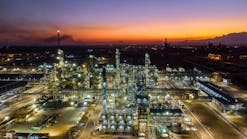GLOBAL UPSTREAM investment is expected to increase in 2017, some analysts say, perhaps by 1.7%. While only a slight uptick, it would mark the first such increase since 2014. For many, ushering in a new year means a fresh start and a renewed sense of possibilities. As the oil and gas industry looks to move on from an intense downturn, calls for increased upstream investment are welcome.
On the heels of a 21% decrease in global upstream spending in 2015, a subsequent decrease of 27% in 2016 put the two-year period on the books as "the first consecutive annual decline since the mid-1980s," according to Evercore ISI analysts.
Not that many of us need it, but analysts at Wood Mackenzie painted a picture of the damage following the oil price crash of late 2014. Following an all-time high of US$760 billion in 2014, Wood Mackenzie said, global upstream spend, including exploration, "reduced investment to US$438 billion in 2016, 42% below the peak. Discretionary spend was swiftly withdrawn from unconventionals and exploration, and cuts have spread to all resource themes and almost all geographies over the last two years. Investment in conventional greenfield projects virtually dried up."
Further, Wood Mackenzie noted, "financial stress across the industry contributed to the investment vacuum. Negative cash flow and weakening balance sheets forced companies to preserve capital, cutting costs, dividends and spend."
Now, however, as we enter the new year, the backdrop by which E&P companies will create budgets has changed. That period of contraction mentioned above? That helped stabilize finances, Wood Mackenzie said. "The industry now needs an oil price of just US$55/bbl to break even on cash flow, down from US$100/bbl in 2014." A "more solid platform from which to consider new investment," indeed.
November's OPEC agreement sets the stage for a potential cut of 1.2 MMbbl/d, significantly improving commodity price visibility and removing significant uncertainty on the supply side through at least the first half of 2017, said Evercore ISI analysts. The deal also pushed WTI past $50/bbl, "a crucial psychological barrier for E&Ps," they continued.
Looking back at its mid-year 2016 Global E&P spending report, Evercore analysts recalled that 2/3 of respondents "indicated that they would raise CAPEX by more than 10% if crude prices moved into the $50/bbl-$55/bbl range."
So here we are, teetering with such numbers, entering formal E&P budget announcement season. While Evercore expects international spending to fall by 4.1% in 2017, it's a step forward, and likely marks "the bottom for international capex," the analysts said, pointing to the 21% decline of 2016. When looking at the big picture, however, expect an overall global increase, with North America leading the recovery.
"Emerging from the bottom, North America will usher in the upcycle with a 21% increase in E&P capex in 2017, led by a 25% increase in the US. Canadian capex is projected to increase by a more modest 10% for the year," said Evercore analysts, noting a potential rise in the projections for several reasons. "First, a substantial amount of our data reflects pre-OPEC agreement conservatism in budgeting and estimates, and formal budget announcements post-OPEC agreement have shown substantial increases to the tune of ~60% (with a bias towards NAM). Secondly, current oil prices already exceed average prices respondents used to budget 2017 capex. Lastly, we expect commodity prices to continue to improve throughout the year, increasing E&P cash flow and subsequently upstream investment," they explained.
As of this writing, a few North American companies had already announced 2017 spending plans. PDC Energy looks to increase its spending by 78% to $750 million, growing production by 40%. Ring Energy also announced an increase in spending. Calgary-based Canadian Natural Resources Ltd. set its initial 2017 capital budget at $3.89 billion (Can.), just above its 2016 capital spending of $3.845 billion (Can.).
There are several factors to watch. OPEC shows up on the flipside of the equation, as well. Can and will it execute on the production cuts to the extent announced? The oilfield services sector could play a role as it looks to recover revenue sacrificed as concessions during the downturn. Will 2017 be the year of pricing increases?
You may not find many willing to make bold future predictions about the industry at this point, but, with the aforementioned caveats in mind, Wunderlich Securities analyst Irene Haas summed up the immediate outlook nicely. "It is comforting to see that after more than two years in turmoil, the oil and gas sector can now plan for a brighter 2017. While we are wary of OPEC's ability to execute and monitor the 1.2 MMbbl/d production cut being pledged by its members (in addition to the non-OPEC pledge of 558,000 bbl/d cut), recent developments point to how painful this self-imposed market share war has been for OPEC and the extent of the collateral damage. We are cautiously optimistic going into 2017 and would pay attention to how producers plan to iron-clad their spending for 2017."
We, too, will be watching.

Mikaila Adams | Managing Editor - News
Mikaila Adams has 20 years of experience as an editor, most of which has been centered on the oil and gas industry. She enjoyed 12 years focused on the business/finance side of the industry as an editor for Oil & Gas Journal's sister publication, Oil & Gas Financial Journal (OGFJ). After OGFJ ceased publication in 2017, she joined Oil & Gas Journal and was named Managing Editor - News in 2019. She holds a degree from Texas Tech University.

